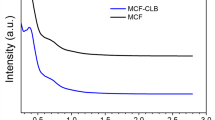Abstract
Mesostructure cellular foam (MCF) materials were modified with hydrophobic polyisoprene (PI) through free radical polymerization in the pores network, and the resulting materials (MCF-PI) were investigated as matrices for drug storage. The successful synthesis of PI inside MCF was characterized by Fourier transform infrared (FT-IR), hydrogen nuclear magnetic resonance (1H NMR), X-ray diffraction patterns (XRD) and nitrogen adsorption/desorption measurements. It was interesting to find the resultant system held a relatively large pore size (19.5 nm) and pore volume (1.02 cm3 g−1), which would benefit for drug storage. Ibuprofen (IBU) and vancomycin were selected as model drugs and loaded onto unmodified MCF and modified MCF (MCF-PI). The adsorption capacities of these model drugs on MCF-PI were observed increase as compared to that of on pure MCF, due to the trap effects induced by polyisoprene chains inside the pores. The delivery system of MCF-PI was found to be more favorable for the adsorption of IBU (31 wt%, IBU/silica), possibly attributing to the hydrophobic interaction between IBU and PI formed on the internal surface of MCF matrix. The release of drug through the porous network was investigated by measuring uptake and release of IBU.









Similar content being viewed by others
References
Fagundes LB, Sousa TGF, Sousa A, Silva VV, Sousa EMB (2006) SBA-15-collagen hybrid material for drug delivery applications. J Non-Cryst Solids 352:3496–3501
Fu Q, Rao GV-R, Zsta LK, Wu Y, Andrzejewski BP, Sklar LA, Ward TL, Lopez GP (2003) Control of molecular transport through stimuli-responsive ordered mesoporous materials. Adv Mater 15:1262–1266
Juan CD, Edesia MBS, Isabel I-B, Antonio LD, Joaquin P-P, Maria V-R (2006) Functionalization of mesoporous materials with long alkyl chains as a strategy for controlling drug delivery pattern. J Mater Chem 16:462–466
Nasongkla N, Shuai X, Ai H (2004) cRGD-functionalized polymer micelles for targeted doxorubicin delivery. Angew Chem Int Ed 43:6323–6327
Sauer J, Marlow F, Schüth F (2001) Simulation of powder diffraction patterns of modified ordered mesoporous materials. Phys Chem Chem Phys 3:5579–5584
Schmidt-Winkel P, Lukens WW, Zhao D, Yang P, Chmelka BF, Stucky GD (1999) Mesocellular siliceous foams with uniformly sized cells and windows. J Am Chem Soc 121:254–255
Schmidt-Winkel P, Lukens WW, Yang P, Margolese DI, Lettow JS, Ying JY, Stucky GD (2000) Microemulsion templating of siliceous mesostructured cellular foams with well-defined ultralarge mesopores. Chem Mater 12:686–696
Song S-W, Hidajat K, Kawi S (2005) Functionalized SBA-15 materials as carriers for controlled drug delivery: Influence of surface properties on matrix–drug interactions. Langmuir 21:9568–9575
Vallet-Regí M, Ruiz-Gonza´lez L, Izquierdo-Barba I, Gonza´lez-Calbet JM (2006) Revisiting silica based ordered mesoporous materials: Medical applications. J Mater Chem 16:26–31
Yang Q, Wang S, Fan P, Wang L, Di Y, Lin K, Xiao F (2005) pH-responsive carrier system based on carboxylic acid modified mesoporous silica and polyelectrolyte for drug delivery. Chem Mater 17:5999–6003
Yiu HHP, Botting CH, Botting NP, Wright PA (2001) Size selective protein adsorption on thiol-functional SBA-15 mesoporous molecular sieve. Phys Chem Chem Phys 3:2983–2985
Zhao D, Feng J, Huo Q, Melosh N, Fredrickson GH, Chmelka BF, Stucky GD (1998a) Triblock copolymer syntheses of mesoporous silica with periodic 50 to 300 angstrom pores. Science 279:548–552
Zhao D, Huo Q, Feng J, Chmelka BF, Stucky GD (1998b) Nonionic triblock and star diblock copolymer and oligomeric surfactant syntheses of highly ordered, hydrothermally stable, mesoporous silica structures. J Am Chem Soc 120:6024–6036
Zhou Z, Zhu S, Zhang D (2007) Grafting of thermo-responsive polymer inside mesoporous silica with large pore size using ATRP and investigation of its use in drug release. J Mater Chem 17:2428–2433
Acknowledgements
The authors greatly acknowledge the financial support of this research by the National Science Foundation of China (Nos. 50573013, 50772067) Shanghai Science and Technology Committee (Nos. 05ZR14077, 06PJ14063, 07DJ14001), the Scientific Research Foundation for the Returned Overseas Chinese Scholars (State Education Ministry). The authors thank SJTU Instrument Analysis Center for the measurements.
Author information
Authors and Affiliations
Corresponding author
Rights and permissions
About this article
Cite this article
Zhu, S., Zhang, D. & Yang, N. Hydrophobic polymers modification of mesoporous silica with large pore size for drug release. J Nanopart Res 11, 561–568 (2009). https://doi.org/10.1007/s11051-007-9325-4
Received:
Accepted:
Published:
Issue Date:
DOI: https://doi.org/10.1007/s11051-007-9325-4




